Bahrain Cloud Kitchens Market Outlook to 2030
By Operating Model, By Cuisine Cluster, By Order Channel, By Facility Size, By Price Tier, and By Location Cluster
- Product Code: TDR0233
- Region: Middle East
- Published on: August 2025
- Total Pages: 110
Introducing the World's FirstPay-Per-Section Market Reports
Why pay for the full report when you need just a part?
Start Building Your Report
Scroll down to see available sections
Report Summary
The report titled “Bahrain Cloud Kitchens Market Outlook to 2030 – By Operating Model, By Cuisine Cluster, By Order Channel, By Facility Size, By Price Tier, and By Location Cluster” provides a comprehensive analysis of the delivery-first F&B ecosystem in Bahrain. The report covers an overview and genesis of the industry, overall market size in terms of revenue and orders; market segmentation. It further details trends and developments, the regulatory landscape, customer-level profiling, issues and challenges, and a competitive landscape including competition scenario, cross-comparison, opportunities and bottlenecks, and company profiling of major players. The report concludes with future market projections based on order volumes, operating models, cuisine mix, location corridors, service-level performance, and partnership structures, alongside cause-and-effect relationships and success case studies highlighting the major opportunities and cautions for operators, investors, and ecosystem partners.
Bahrain Cloud Kitchens Market Overview and Size
The global cloud kitchen market is valued at USD 64.47 billion, based on recent industry estimates, with projections showing growth to USD 70.18 billion the following year. Regionally, the GCC (including Bahrain) cloud kitchen market reached USD 2.0 billion, backed by strong digital adoption, shifts toward delivery models, and the cost-efficiency of virtual kitchens.
Within the GCC, nations such as the UAE and Saudi Arabia dominate, driven by high urbanization, a large expatriate base, and robust food delivery infrastructure. Their maturity in aggregator presence and high disposable incomes support cloud kitchen proliferation. Bahrain benefits from similar structural advantages—high internet penetration, tourism, and rapid technology adoption—making it well-positioned within this regional trend.
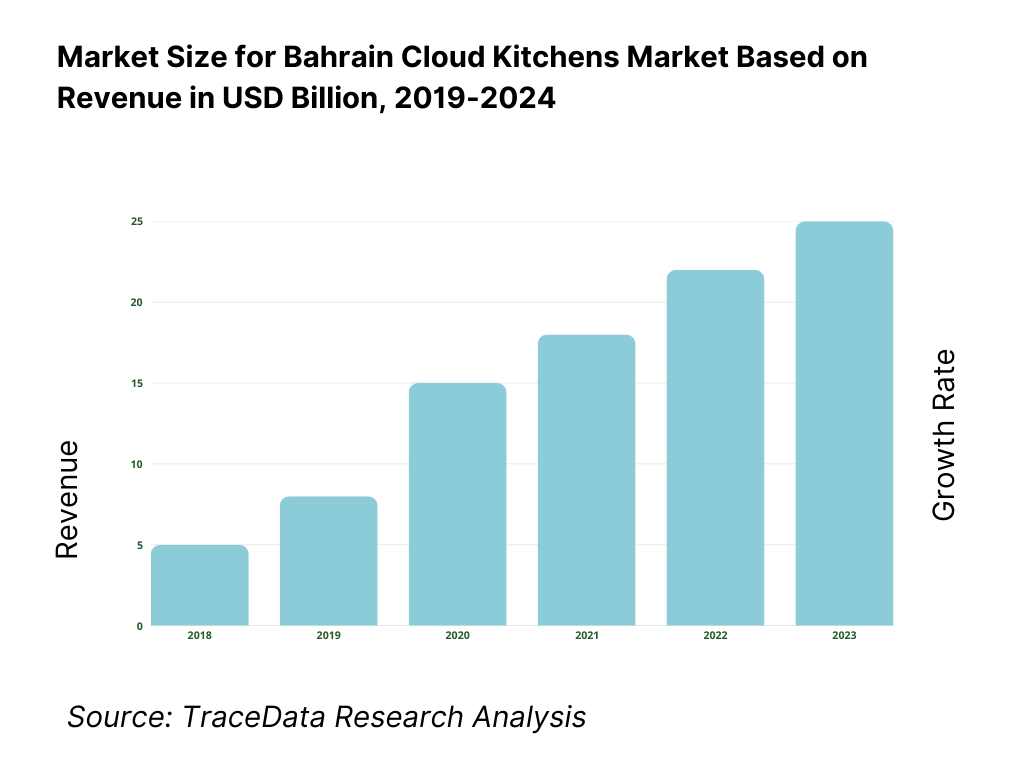
What Factors are Leading to the Growth of the Bahrain Cloud Kitchens Market:
High internet penetration: Bahrain’s cloud-kitchen growth is underpinned by ubiquitous connectivity and a dense, mobile-first consumer base. The telecom regulator reports 2.56 million active mobile subscriptions in Q4, against a resident population of 1,588,670, and 210,572 fixed-broadband lines in the same period. Digital payment rails are equally pervasive: the central bank logged 17.6 million POS transactions in August with a value of BHD 392.5 million and 16.2 million transactions worth BHD 371.9 million in January. For delivery aggregators and virtual restaurants, this translates into instant addressable reach, faster conversion and low-friction checkouts that support higher order frequencies and cross-sell campaigns.
Aggregator marketing spend: While platforms do not disclose budgets, macro usage shows paid acquisition and promotions can land on a large pool of frequent transactors. POS systems processed 16.2–17.6 million card transactions monthly in January–August and cleared BHD 371.9–392.5 million in value. On the discovery side, there were 2.56 million active mobile lines (TRA) and a national population of 1,588,670, ensuring campaign frequency caps and re-targeting pools remain deep. The government’s Sijili scheme lets solo operators sell entirely online across 39 permitted activities, enabling hundreds of micro-brands to join aggregator marketplaces quickly and react to campaigns without renting frontage. For cloud kitchens, this macro transacting base and rapid seller-onboarding environment amplifies ROI from ad spend into same-day orders.
Real estate flexibility: Kitchen footprints scale faster because Bahrain streamlined permits and allowed virtual CRs. The national Benayat system cleared 522 building permits in a single month with approvals typically within 2–5 working days, and nationwide building-permit issuance reached 6,550 over the year. Virtual CR “Sijili” allows operation without a physical office across 39 activities, removing address constraints for back-of-house kitchens and delivery-only brands. Together, rapid permitting and virtual licensing reduce time-to-open for dark kitchens, support hub-and-spoke commissaries, and allow relocation within the urban core without costly storefront moves.
Which Industry Challenges Have Impacted the Growth of the Bahrain Cloud Kitchens Market:
Commission pressure: Vendor commission debates are exacerbated by imported input exposure and headline costs rather than fee schedules alone. Bahrain’s total goods imports reached BD 5,872 million in 2024, up from BD 5,778 million, meaning restaurants and kitchens buy ingredients priced off foreign supply chains. The Consumer Price Index stood close to 101.5–102.0 index points in May–August, with food and transport sub-indices anchoring household baskets. With a fixed exchange rate at 0.376 BHD per USD and high openness to trade, import valuations directly flow into kitchen P&Ls, narrowing room for platform fees before profitability. These macro numbers, not menu-level price points, explain why operators frequently cite “commission pressure” during contract renewals.
Rider availability & labor constraints: Delivery reliability hinges on Bahrain’s labor market structure. The LMRA issued 41,792 new permits in Q2, including 33,740 employment work permits—an active pipeline that feeds last-mile roles. A sectoral view shows 38,034 workers in transport and logistics, indicating a sizable base for courier recruitment and fleet ops. With a total population of 1,588,670 and 22,699 net migrants, seasonal supply swings are manageable but contingent on visa processing and retention. For cloud kitchens, these numbers underscore the need for hybrid models (in-house riders plus aggregator fleets) and incentives pegged to permit inflows and sectoral employment depth.
Food safety compliance: Import-dependent food chains face rigorous checks before products reach a kitchen. In 2024, authorities conducted over 12,000 laboratory tests on agricultural and livestock products at entry points to ensure compliance, with border controls covering 522,000 tonnes of food and 155,000 head of livestock—figures highlighting inspection throughput that operators must plan for in their inbound lead times (MoMAA via BNA coverage; Bahrain food import checks). Operationally, the “Permit for the entry of imported food products” requires an inspection application, packing list, transport document and a health certificate for every shipment (Gov service). These concrete checkpoints—and the documentation volume tied to each consignment—add predictable but non-trivial compliance time to cloud-kitchen inventory cycles.
What are the Regulations and Initiatives which have Governed the Market:
Commercial Registration (CR) via Sijilat: Bahrain enables end-to-end online setup through Sijilat and the Al-Tajir app, including CR issuance, renewals, and activity additions. The virtual CR stream Sijili expressly permits 39 activities without a physical office, granting legal status to sole proprietors selling online—relevant to delivery-only food brands and chef-preneurs who start with home-base commissaries before upgrading to dedicated units.
Municipal license & zoning: Kitchen buildouts route through Benayat, the national building-permit platform. Authorities highlight 6,550 permits issued during 2024, and routine approvals within 2–5 working days for typical submissions, which accelerates fit-outs or reconfigurations of delivery-only premises. For operators, this compresses the critical path on ventilation, drainage and fire-safety works that are essential for multi-brand kitchens and nighttime throughput.
Ministry of Health food-safety approvals: Every imported food consignment requires a formal “Permit for the entry of imported food products”, which triggers inspection and documentation checks (application, packing list, bill of lading/airway bill, and an exporting-country health certificate) before market entry (Gov service). At border gates, authorities undertook over 12,000 laboratory tests in 2024 on agricultural and livestock products, capturing inbound risks early and aligning with food control protocols that cloud kitchens must plan for in replenishment cycles
Bahrain Cloud Kitchens Market Segmentation
By Operating Model: Commissary/shared kitchens dominate in Bahrain’s landscape, accounting for roughly 60% of cloud kitchen capacity. Shared kitchens offer economies of scale in rent and infrastructure, lowering the capital barrier for brand operators. They enable emerging virtual brands to test menus without full capex, while aggregators prefer centralized hubs to optimize delivery logistics and menu variety. This model provides flexibility, cost savings, and rapid setup—crucial in Bahrain’s dense, competitive food-delivery ecosystem.
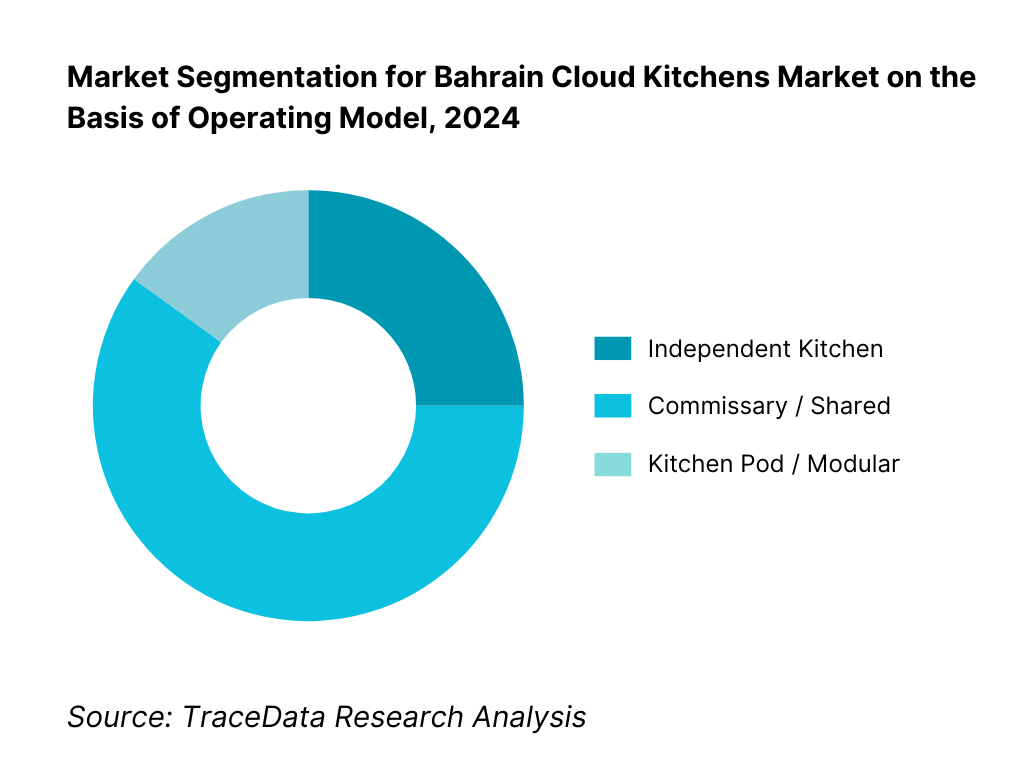
By Cuisine Type: International/Pan-Asian offerings hold about 55% of the market in Bahrain. The cosmopolitan taste profile of residents and tourists favors diverse Pan-Asian and international menus. Virtual brands serving sushi, noodles, bowls, and fusion fare appeal strongly on aggregator platforms. In contrast, while local Khaleeji cuisine remains culturally significant, it lacks the broad competitive variety. Health-focused meal plans are growing but still niche, accounting for about 15%.
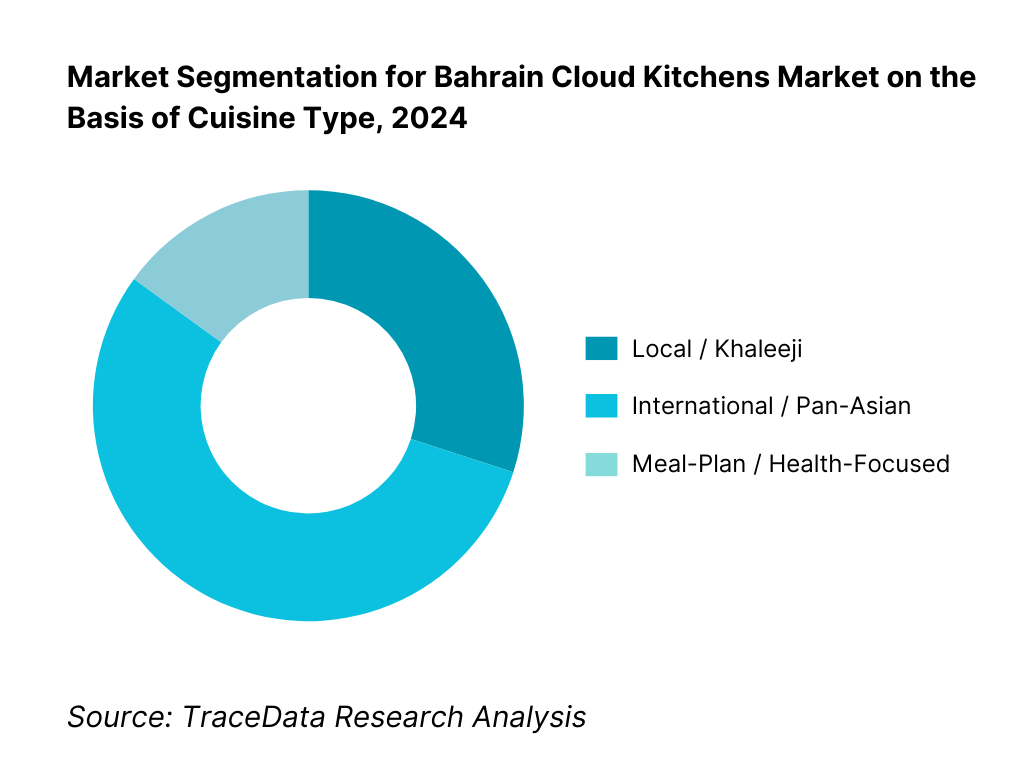
Competitive Landscape in Bahrain Cloud Kitchens Market
The Bahrain cloud kitchens market is increasingly consolidated among several key operators which shape industry dynamics. A small number of dominant players—including multi-brand facilitators, aggregator-backed operators, and virtual brand incubators—are leading the market. The competitive environment reflects strategic real estate positioning, strong aggregator partnerships, and capability in multi-cuisine virtual offerings, reinforcing their influence and operational advantage.
Name | Founding Year | Headquarters |
Kitopi | 2018 | Dubai, UAE |
KLC Virtual Restaurants (One Eatery) | 2018 | Kuwait City, Kuwait |
Hidden Stations (DGc Holding) | 2021 | Manama, Bahrain |
KitchenPark | 2020 | Manama, Bahrain |
Eatco / Eat Station | 2019 | Manama, Bahrain |
Calo (Meal-Plan Cloud Kitchens) | 2019 | Manama, Bahrain |
Talabat (Aggregator-led Dark Kitchens) | 2004 | Kuwait City, Kuwait |
Jahez Bahrain | 2016 | Riyadh, Saudi Arabia |
Careem Food | 2012 | Dubai, UAE |
HungerStation | 2012 | Riyadh, Saudi Arabia |
Dine In (Premium Delivery Partner) | 2014 | Manama, Bahrain |
Wasel Delivery | 2016 | Manama, Bahrain |
Virtual Dining Concepts / MrBeast Burger | 2018 | Orlando, USA |
Al Abraj / Nu Asia Group (Cloud Brands) | 1987 | Manama, Bahrain |
Alshaya Food (Central Kitchen Ops) | 1890 | Kuwait City, Kuwait |
Some of the Recent Competitor Trends and Key Information About Competitors Include:
Kitopi: Accelerating multi-brand rollouts across prime delivery corridors in Manama and Muharraq, with a heavier push on data-driven menu engineering (A/B pricing, SKU rationalization) and centralized procurement to stabilize input costs. Expanding hotel/real-estate partnerships and tightening delivery SLAs through tighter batching and order throttling.
KLC Virtual Restaurants (One Eatery): Broadening its GCC virtual brand portfolio in Bahrain with comfort-food and Pan-Asian concepts tailored for aggregator discovery. Emphasis on standardized recipes and modular kitchen lines to improve station throughput and reduce capex per launch.
Hidden Stations (DGc Holding): Adding chef-led niche cuisines and late-night offerings to capture incremental demand windows. Investing in premium, heat-retaining packaging and rider-handoff SOPs to lift post-delivery experience and ratings.
KitchenPark: Scaling a Kitchen-as-a-Service (KaaS) model for SMEs with flexible tenancy (single line, multi-line, shared prep). Prioritizing near-bridge, high-density zones to reduce last-mile costs; strengthening HACCP compliance and shared cold-chain to attract enterprise brands.
Eatco / Eat Station: Evolving a “virtual food hall” approach with rotating pop-up brands and dessert add-ons to increase ticket size. Leveraging cross-brand bundles and combo logic on aggregator menus to raise AOV while keeping prep complexity contained.
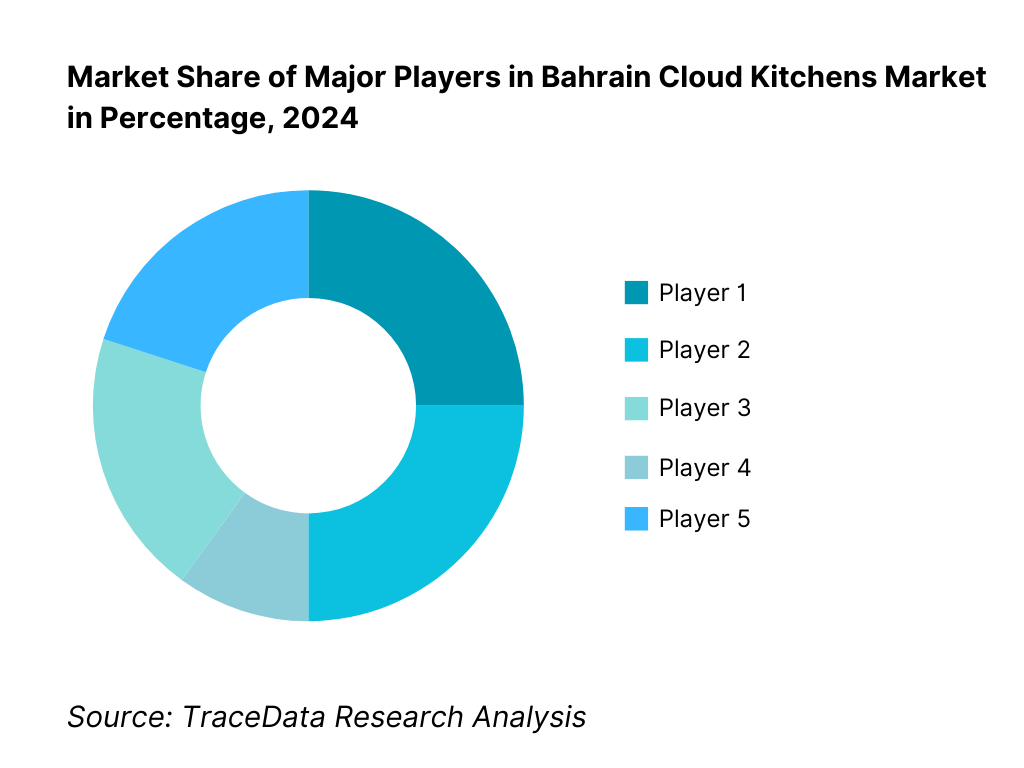
What Lies Ahead for Bahrain Cloud Kitchens Market
The Bahrain cloud kitchens market is poised for steady expansion through the medium term, underpinned by deep aggregator penetration, a dense mobile-first consumer base, and pro-business enablers like Sijilat/Sijili virtual commercial registration and rapid building-permit approvals via Benayat. Growth will be reinforced by tourism inflows, a sizeable expatriate population, and the continued shift toward delivery-first consumption across weekday lunch and late-night windows. Operators that combine disciplined unit economics with brand licensing, hotel partnerships, and menu engineering will be best positioned to capture incremental demand without heavy front-of-house capex.
Rise of Hybrid Fulfilment Models: Expect a clear pivot from single-format “dark kitchens” to hybrid configurations that mix Kitchen-as-a-Service (rent-a-line), managed multi-brand hubs, hotel-hosted kitchens, and selective dine-in or click-and-collect counters at low-rent sites. These hybrids let operators match dayparts to the optimal prep/dispatch node, smooth rider handoffs, and flex labor across brands. For Bahrain’s compact geography, hub-and-spoke networks near bridges and high-density corridors will compress ETAs, while modular pods help test micro-markets with minimal fit-out. The net effect is faster concept iteration and better utilization of capex and crew hours.
Focus on Outcome-Based Operations: The competitive edge will shift from “more brands per box” to measurable operating outcomes: stable contribution margins, on-time dispatch rates, order accuracy, and customer repeat rates. Kitchens will institutionalize prep-finish splits, cook-chill for high runners, and strict QA sampling to reduce refunds and re-fires. Cross-brand menu engineering, SKU rationalization, and disciplined promotion mechanics will replace blanket discounting. Operators that anchor performance reviews in hard metrics—AOV levers, throughput per workstation, cancellation/stock-out rates, and ratings recovery—will outperform as aggregator algorithms increasingly reward reliability and customer satisfaction.
Expansion of Sector- & Occasion-Specific Kitchens: Beyond generalist menus, Bahrain will see deeper specialization: corporate catering lines optimized for bulk, nutrition-led meal-plan facilities serving gyms and workplaces, late-night formats for entertainment districts, and hospitality-attached kitchens targeting tourists and short-stay residents. Cuisine whitespaces—health-forward bowls, premium regional Asian, high-quality desserts—will be filled by virtual brands with tight packaging specs and reheating protocols. Occasion-specific bundling (family trays, office platters, weekend brunch kits) will raise ticket sizes without slowing the line, while licensing deals with regional and creator-led brands provide fast demand onboarding.
Leveraging AI & Analytics: AI will permeate demand forecasting, dynamic 86ing, and labor scheduling, turning historical order curves and live traffic into minute-by-minute throttling rules. Menu analytics will identify low-yield SKUs, propose profitable swaps, and personalize bundles per micro-market. Routing intelligence will tighten door-to-door times by optimizing batching and rider staging. Computer vision and IoT sensors will track prep compliance and food safety logs automatically. Kitchens that wire up POS, KDS, inventory, and aggregator APIs into a single data spine will cycle faster through test-and-learn loops—capturing incremental volume while holding service quality steady.
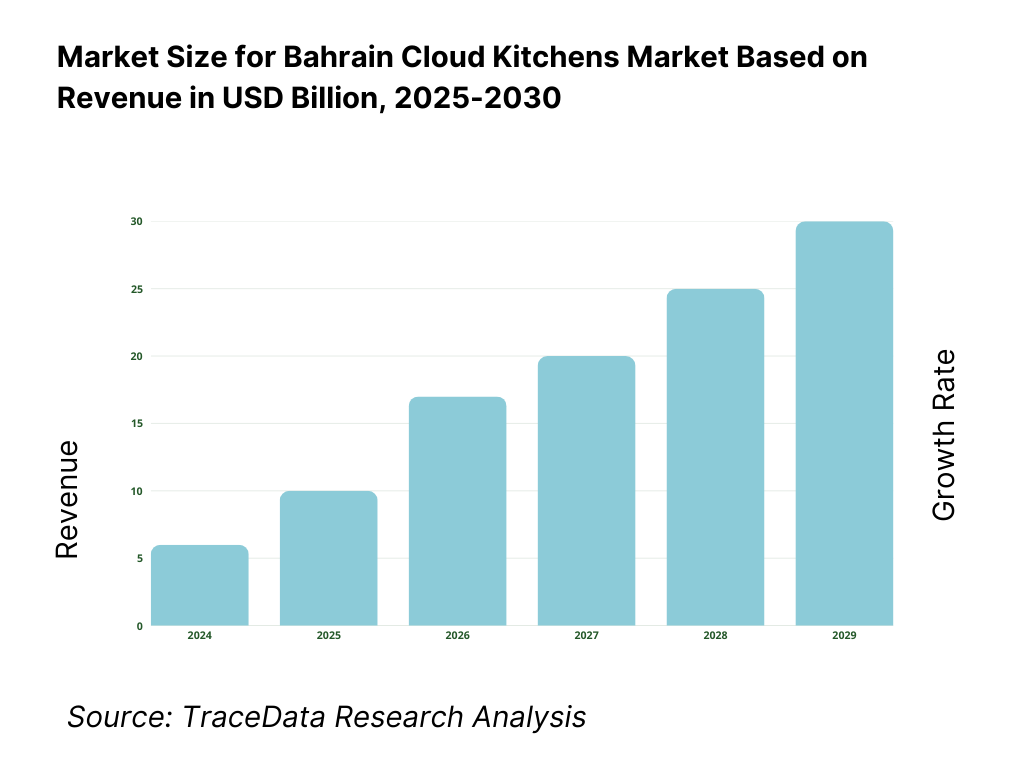
Bahrain Cloud Kitchens Market Segmentation
By Operating Model
Independent Single-Brand Kitchens
Commissary / Shared-Kitchen Hubs
Modular Pod Kitchens
By Cuisine / Proposition Type
Local / Khaleeji Cuisine
International / Pan-Asian / Fusion
Meal-Plan / Health-Focused Kitchens
By Order Channel
Aggregator Platform (Talabat, Jahez, etc.)
Direct Orders (Own App/Web)
Subscriptions / Meal-Plan Packages
By Price Tier
Budget (low-cost QSR)
Mid-Market
Premium / Gourmet
By Location Cluster
Manama / Seef / Juffair
Muharraq / Amwaj
Riffa / Isa Town
Saar / Janabiya
Hamad Town / Peripheral Areas
Players Mentioned in the Report:
Kitopi
KLC Virtual Restaurants (One Eatery)
Hidden Stations (DGc Holding)
KitchenPark
Eatco / Eat Station
Calo (Meal-Plan Kitchens)
Talabat (Dark-store adjacencies)
Jahez Bahrain
Dine In (Premium Delivery)
Careem Food (Bahrain)
HungerStation (Bahrain)
Wasel Delivery
Virtual Dining Concepts / MrBeast Burger
Al Abraj / Nu Asia Group
Alshaya Food (Central Kitchens)
Key Target Audience
Regional Cloud Kitchen Operators (multi-brand hub models)
Food Delivery Aggregators (Talabat, Jahez, Careem, HungerStation)
Strategic Restaurant Groups expanding into virtual concepts
Real Estate Developers focusing on shared kitchen spaces
Investment & Venture Capitalist Firms (focused on F&B innovations)
Hospitality Chains seeking cloud kitchen partnerships
Government & Regulatory Bodies
Packaging and Supply Chain Providers for delivery-only formats
Time Period:
Historical Period: 2019-2024
Base Year: 2025
- Forecast Period: 2025-2030
Report Coverage
Choose individual sections to purchase. Mix and match as you like.
- -
- -
- $100
4.1. Delivery Model Analysis-Kitchen-as-a-Service, Multi-Brand Operators, Restaurant-Hosted Virtual Brands, Hotel-Hosted, Meal Plan/Ready Meals (Margins, Preference, Strengths and Weaknesses)
4.2. Revenue Streams for Bahrain Cloud Kitchens Market [Commission, Subscription Models, Licensing, White-Label Partnerships, Corporate Catering]
4.3. Business Model Canvas for Bahrain Cloud Kitchens Market
$2505.1. Independent Cloud Kitchens vs Aggregator-Backed Kitchens
5.2. Investment Model in Bahrain Cloud Kitchens Market [Venture Capital, Hospitality Partnerships, Franchise-Licensing, Real Estate Co-Investments]
5.3. Comparative Analysis of Order Funneling via Aggregators vs Direct Brand Apps
5.4. Kitchen Setup Costs & Ongoing Opex Benchmarks (Rental, Staff, Utilities, Packaging, Commission)
$150- $100
- $200
8.1. Revenues, 2019-2025
$3009.1. By Market Structure (Independent vs Aggregator-Backed)
9.2. By Cuisine Cluster (Arabian/Khaleeji, Indian, Pan-Asian, American QSR, Health/Meal-Plan, Desserts/Bakery)
9.3. By Industry Verticals Served (Hospitality, Corporate Catering, Food Delivery Aggregators, Retail Hubs, Airport Zones)
9.3.1. By Type of Health & Meal-Plan Kitchens
9.3.2. By Type of Multi-Brand Operators
9.3.3. By Type of Aggregator-Exclusive Kitchens
9.3.4. By Type of Franchise/Brand-Licensed Kitchens
9.4. By Kitchen Size (Micro, Standard, Large Facilities)
9.5. By Customer Segment (Singles/Expats, Families, Office Workers, Tourists, Fitness/Wellness-Oriented Customers)
9.6. By Order Channel (Aggregator App, Direct App/Web, Subscription/Meal Plans, Corporate Orders)
9.7. By Price Tier (Budget, Mid-Market, Premium)
9.8. By Region (Manama/Seef/Juffair, Muharraq/Amwaj, Riffa/Isa Town, Saar/Janabiyah, Hamad Town)
$40010.1. Customer Landscape and Cohort Analysis
10.2. Customer Decision-Making Process (Aggregator Promotions vs Direct Loyalty)
10.3. Perceived Quality, Trust, and Brand Affinity
10.4. Gap Analysis Framework (Unmet Needs vs Current Offerings)
$50011.1. Trends and Developments for Bahrain Cloud Kitchens Market [Virtual Food Halls, Smart Kitchens, Subscription Models]
11.2. Growth Drivers [High Smartphone Penetration, Tourism, Flexible Real Estate, Aggregator Growth]
11.3. SWOT Analysis for Bahrain Cloud Kitchens Market
11.4. Issues and Challenges [Commission Pressure, Rider Shortages, Food Safety Compliance, Sustainability Demands]
11.5. Government Regulations for Bahrain Cloud Kitchens Market [CR via Sijilat, Food Safety, Zoning, Civil Defense Compliance]
$20012.1. Market Size and Future Potential for Aggregator-led Delivery in Bahrain
12.2. Business Models and Revenue Streams (Aggregator, Own-Fleet, Hybrid)
12.3. Delivery Models and Cuisine Preferences by Aggregator
12.4. Cross Comparison of Leading Delivery Platforms [Talabat, Jahez, Careem, HungerStation, Dine In, Wasel] based on Company Overview, Investment, Revenues, Order Volume, Commission Structures, SLA, Prime Models
$500- $250
- $150
15.1. Market Share of Key Players in Bahrain Cloud Kitchens Market Basis Revenues
15.2. Benchmark of Key Competitors (Kitopi, KLC Virtual Restaurants, Hidden Stations, KitchenPark, Eatco/Eat Station, Calo, Talabat, Jahez, Careem Food, HungerStation, Dine In, Wasel Delivery, MrBeast Burger/VDC, Al Abraj/Nu Asia Group, Alshaya Food) including Company Overview, USP, Business Strategies, Operating Model, Brand Count, Revenues, Pricing, Technology Used, Cuisine Portfolio, Major Clients, Strategic Tie Ups, Marketing Strategy, Recent Developments
15.3. Operating Model Analysis Framework (Aggregator-Exclusive vs Multi-Channel vs White-Label Licensing)
15.4. Gartner Magic Quadrant for Bahrain Cloud Kitchens
15.5. Bowmans Strategic Clock for Competitive Advantage
$75016.1. Revenues, 2025-2030
$30017.1. By Market Structure (Independent vs Aggregator-Backed), 2025-2030
17.2. By Cuisine Cluster, 2025-2030
17.3. By Industry Verticals Served, 2025-2030
17.3.1. By Type of Health & Meal-Plan Kitchens, 2025-2030
17.3.2. By Type of Multi-Brand Operators, 2025-2030
17.3.3. By Type of Aggregator-Exclusive Kitchens, 2025-2030
17.3.4. By Type of Franchise/Brand-Licensed Kitchens, 2025-2030
17.4. By Kitchen Size, 2025-2030
17.5. By Customer Segment, 2025-2030
17.6. By Order Channel, 2025-2030
17.7. By Price Tier, 2025-2030
17.8. By Region, 2025-2030
$400- $250
- $250
Research Methodology
Step 1: Ecosystem Creation
The first step involves mapping the Bahrain cloud kitchens ecosystem across both demand-side and supply-side entities. On the demand side, this includes delivery aggregators (Talabat, Jahez, Careem, HungerStation), corporate catering clients, health-focused meal-plan subscribers, and end consumers across expat families, single professionals, and tourists. On the supply side, the map covers cloud kitchen operators (Kitopi, Hidden Stations, KitchenPark), real estate enablers, packaging suppliers, logistics and rider fleet providers, food distributors, and regulatory authorities (Ministry of Health, Civil Defense, Municipal Licensing). Based on this mapping, we shortlist 5–6 leading operators in Bahrain according to their brand count, delivery density, aggregator reliance, and operational footprint. Sourcing is conducted through industry articles, Bahrain Economic Vision reports, company disclosures, and proprietary databases to collate ecosystem-level information.
Step 2: Desk Research
A comprehensive desk research process is then undertaken using diverse secondary and proprietary databases. This covers market revenues, operator counts, brand proliferation, aggregator commission structures, and demand trends. Company-level examinations rely on official press releases, financial statements (where available), and annual reports from parent firms and regional investors. Local government datasets (Labour Market Regulatory Authority, TRA, Central Bank of Bahrain) provide macroeconomic benchmarks for rider availability, digital adoption, and transaction frequency. The outcome of this step is a granular understanding of Bahrain’s cloud kitchen unit economics, operator models, and customer adoption trends, forming the backbone of the market assessment.
Step 3: Primary Research
This phase comprises in-depth interviews with C-level executives, kitchen managers, delivery aggregator representatives, and regulators. Interviews are structured to validate working hypotheses on throughput, order fulfillment rates, and kitchen utilization, while also extracting insights into operating challenges such as rider shortages, compliance bottlenecks, and commission negotiations. A bottom-to-top approach is deployed to estimate revenue contribution from each operator segment, aggregated into the overall market landscape. For validation, disguised interviews are occasionally employed, where the team approaches operators as potential clients to triangulate unit economics and service-level disclosures. These interactions enrich understanding of pricing dynamics, menu-engineering practices, labor allocation, and supply chain dependencies.
Step 4: Sanity Check
Finally, a sanity check is executed using both top-to-bottom (macro digital adoption, population, transaction density) and bottom-to-top (operator-level contribution) models. Market size modeling is iterated until figures converge across approaches, ensuring accuracy and robustness. This dual validation approach guarantees that the Bahrain cloud kitchens market assessment reflects a realistic synthesis of both primary insights and macroeconomic realities, avoiding overreliance on either operator self-disclosure or external secondary figures.
FAQs
01 What is the potential for the Bahrain Cloud Kitchens Market?
The Bahrain Cloud Kitchens Market shows strong potential as delivery-first dining deepens across a compact, urbanized geography with high smartphone adoption and seamless digital payments. Pro-business enablers—such as online commercial registration via Sijilat/Sijili, quick-fit approvals through Benayat, and aggregator depth across Talabat, Jahez, Careem Food, and HungerStation—lower time-to-launch and scale. Hospitality tie-ups, creator/licensed virtual brands, and meal-plan models further expand addressable demand, while hub-and-spoke commissaries near high-density corridors compress delivery times and unlock multi-brand throughput without front-of-house capex.
02 Who are the Key Players in the Bahrain Cloud Kitchens Market?
Key operators and ecosystem participants include Kitopi, KLC Virtual Restaurants (One Eatery), Hidden Stations (DGc Holding), KitchenPark, Eatco/Eat Station, and Calo (meal-plan kitchens). Platform and delivery adjacencies shaping discovery and logistics comprise Talabat, Jahez Bahrain, Careem Food, HungerStation, Dine In, and Wasel Delivery. Brand licensors and multi-cuisine groups active in delivery-first formats include Virtual Dining Concepts/MrBeast Burger, Al Abraj/Nu Asia Group, and Alshaya Food. Their combined footprints, aggregator ties, and menu engineering capabilities anchor the current competitive landscape.
03 What are the Growth Drivers for the Bahrain Cloud Kitchens Market?
Expansion is propelled by a dense mobile-first consumer base, frictionless digital payments, and sustained aggregator marketing that steers trial and repeat orders for virtual brands. Flexible real estate and virtual CR options enable rapid rollouts and relocations, while data-driven menu engineering lifts utilization per workstation. Tourism flows, a sizeable expatriate population, and corporate catering/meal-plan demand add steady daypart volume. Partnerships with hotels and malls, plus creator- and franchise-led brand licensing, accelerate customer acquisition without heavy brand-building costs.
04 What are the Challenges in the Bahrain Cloud Kitchens Market?
Operators face margin tension from platform commissions and promotional burn, requiring disciplined contribution management and SKU rationalization. Rider availability and retention affect delivery SLAs and batching efficiency, especially in peak windows. Food-safety compliance and import-dependent supply chains add documentation and lead-time planning to inventory cycles. Tech fragmentation across POS, KDS, inventory, and multiple aggregator APIs can hinder a single view of demand, while brand proliferation risks cannibalization unless differentiated cuisine whitespace and pricing architectures are maintained.